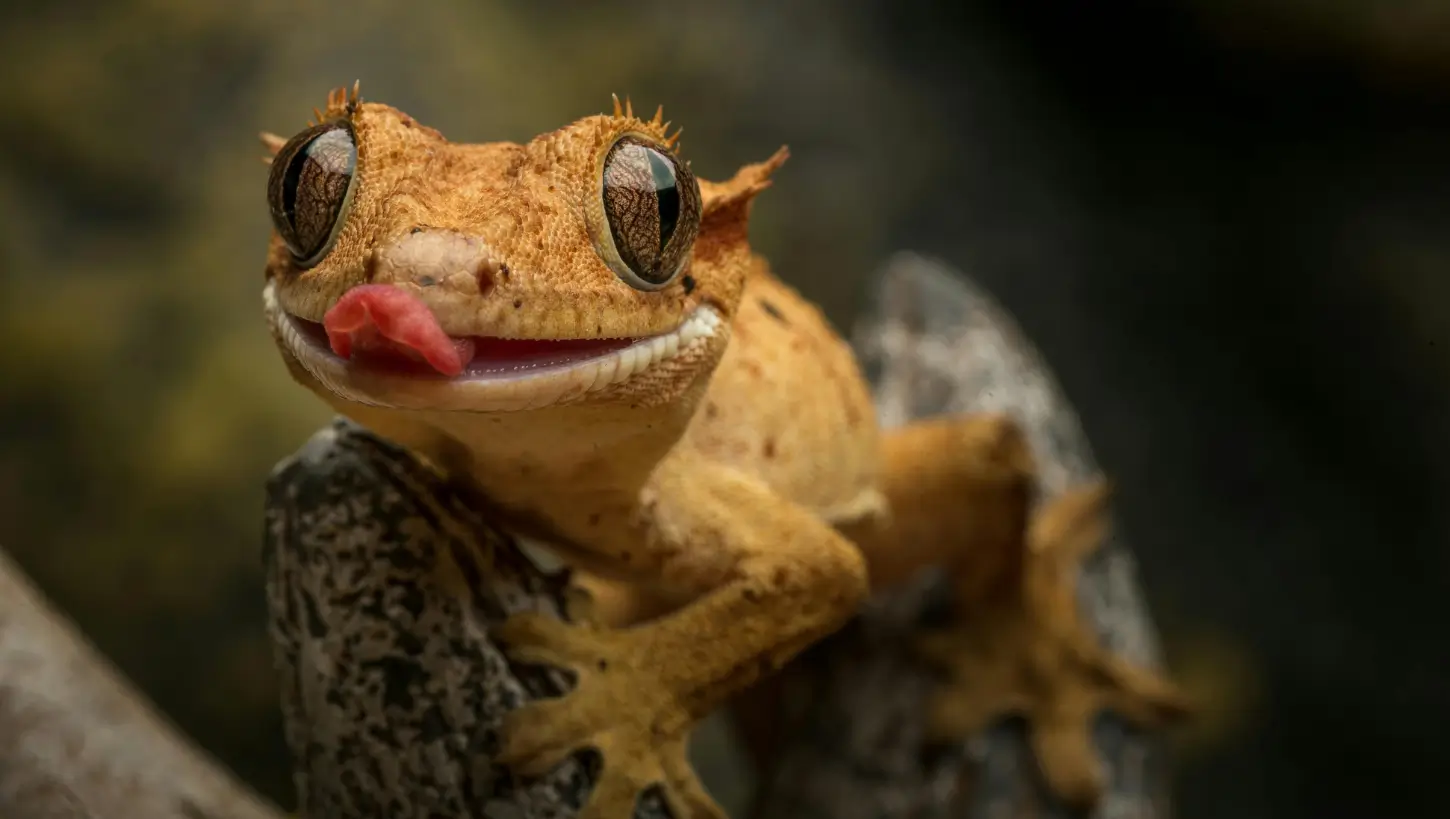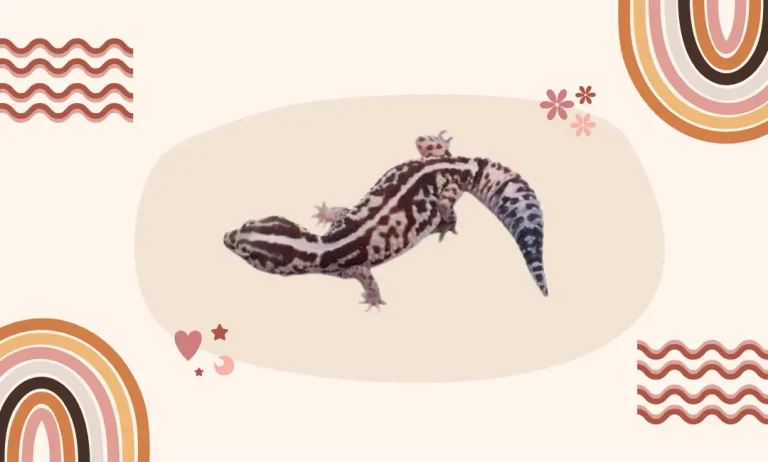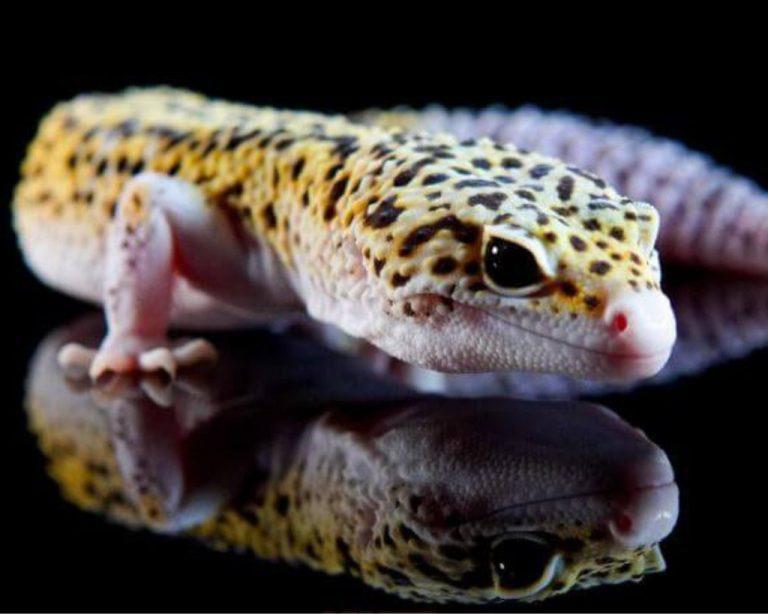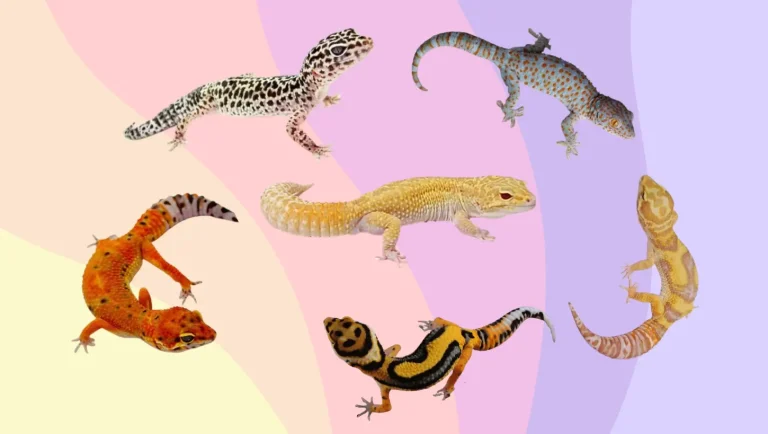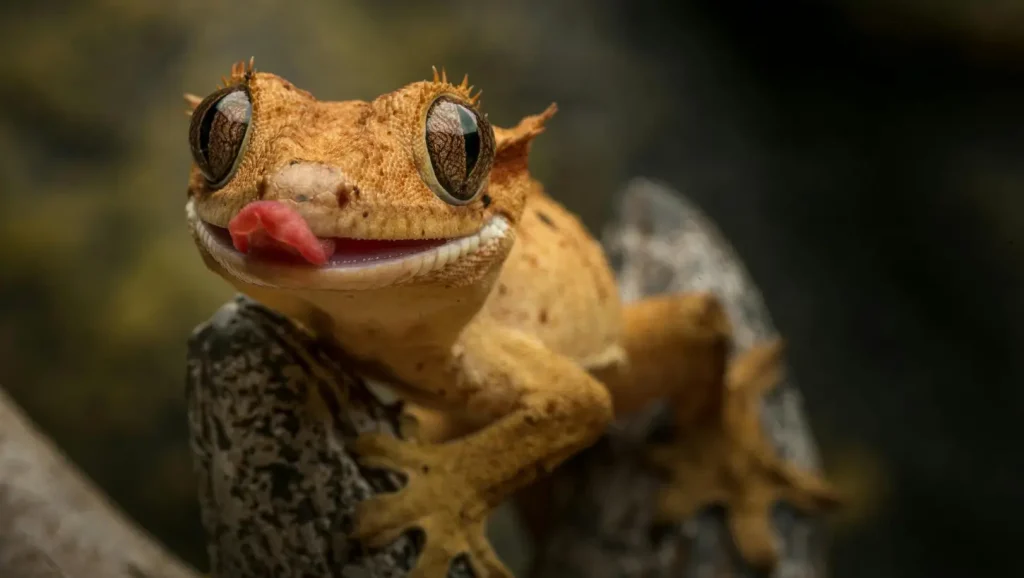
Hey there future lizard enthusiasts! Ready to meet your new scaly friend? Get ready to dive into the fantastic world of crested geckos – the cool, colorful, and easy-to-care-for reptile buddies that are perfect for beginners and families.
These little guys, sometimes called “eyelash geckos,” have a unique charm with their special eyelashes. Originally from an island near Australia called New Caledonia, they were once thought to be gone forever but surprised everyone by making a comeback in 1994. Since then, they’ve become super popular as awesome pets.
In this guide, we’ll walk you through everything you need to know to make sure your crested gecko feels right at home with you. From setting up their cozy space to making sure they’re munching on tasty meals, we’ve got you covered. Let’s embark on this lizard-loving journey together!
Species Overview
Common Names: Crested gecko, New Caledonian crested gecko, eyelash gecko
Scientific Name: Rhacodactylus ciliatus
Adult Size: 7 to 9 inches, including their prehensile tails
Life Expectancy: 10 to 20 years
Crested Gecko Features
Crested geckos boast a diverse array of colors and markings, known as morphs. Their name is derived from the fringed crest that starts over their eyes and extends down their necks and backs, with the size of the crest varying among individuals.
Behavior and Temperament:
While crested geckos typically exhibit docile temperaments, they can be a bit skittish, and care is required when handling. It’s essential to note that they don’t generally enjoy being held, and attempting to do so may cause them to jump away, potentially resulting in injury. Crested geckos may also drop their tails if handled roughly or in an attempt to escape. Unlike some other gecko species, they do not regenerate their tails.
These geckos will only bite if they feel threatened, and while the bites are startling, they are not painful or strong enough to cause bleeding.
Crested geckos are natural climbers, equipped with specialized toe pads that facilitate movement along vertical surfaces. Their prehensile tails, capable of grasping objects, contribute to their agility, and they are excellent jumpers.
Housing:
For adult crested geckos, a 20-gallon terrarium is sufficient, although a larger tank is preferable. Due to their arboreal nature, these geckos require ample vertical space for climbing, making tall tanks the better choice. A 29-gallon terrarium is suitable for housing two or three crested geckos, but keep in mind that male crested geckos can be territorial, so it’s advisable to keep only one male per tank.
The terrarium should be furnished with a variety of climbing structures, including branches, driftwood, cork bark, bamboo, and vines. Silk or sturdy live plants such as Epipremnum, Philodendron, Dracaena, and Ficus provide hiding spots and cover. Daily removal of uneaten food and spot cleaning to eliminate feces is essential, with a complete terrarium cleaning, including decorations, recommended at least once a month using reptile-safe disinfectants.
Heat:
Maintaining an appropriate temperature is crucial for crested geckos, with a daytime gradient of 72–80 degrees Fahrenheit (22 to 26.5 degrees Celsius) and a nighttime range of 65–75 degrees Fahrenheit (18 to 24 degrees Celsius). It’s important to avoid high temperatures, as crested geckos can become stressed. A low-wattage red nighttime bulb serves as a suitable heat source, also allowing for nighttime observation when these nocturnal creatures are most active.
Light:
Crested geckos are nocturnal, and while they technically do not require special UVB lighting, some experts suggest a low level of UVB (about 5%) for overall reptile health. If additional lighting is introduced, provide hiding spots to allow geckos to escape the light if desired.
Humidity:
Maintaining a moderate to high humidity level of about 50–70% is essential for crested geckos. Regular misting with warm, filtered water is recommended, with a hygrometer used to monitor humidity levels. Misting may need to occur multiple times a day, especially if the cage setup requires it. For those unable to mist the enclosure manually, an automatic mister or fogger can be employed to maintain humidity at timed intervals.
Substrate:
Selecting an appropriate substrate is crucial for the health of crested geckos. Ideal options include coconut fiber bedding, moss, or peat, providing both safety and humidity retention. Paper towels or newspaper are acceptable alternatives, particularly for juveniles, although less aesthetically pleasing.
Avoid substrates like gravel, reptile sand, or non-organic soil, as these pose ingestion hazards and are challenging to clean thoroughly.
Feeding and Diet:
Crested geckos generally thrive on commercial diets, providing a convenient and nutritionally balanced option. Supplementing their diet with crickets and other prey insects like roaches, waxworms, and silkworms is recommended. It’s advisable to avoid mealworms due to their hard, indigestible exoskeleton.
Insects should be slightly smaller than the space between the gecko’s eyes and gut-loaded (fed nutritious foods) before feeding. Dusting insects with a calcium/vitamin D3 powdered supplement three times a week enhances the gecko’s vitamin and mineral intake. Additionally, a weekly dusting with a multivitamin powder supplement is beneficial.
Crested geckos also enjoy fruit, with favorites including bananas, peaches, nectarines, apricots, papaya, mangoes, pears, and passion fruit. A small shallow water dish with fresh water should be provided daily, although these geckos often prefer drinking water droplets from leaves in their humid habitat.
Common Health Issues:
Just like any pet, crested geckos can sometimes face health challenges. Being attentive to signs of discomfort and knowing how to address common issues is crucial for ensuring your scaly friend stays happy and healthy. Here are some common health concerns for crested geckos and what you can do about them:
1. Mouth Rot or Stomatitis
Signs: Excess mucus and redness around the mouth.
Action: If you notice these signs, consult with an exotic pet veterinarian promptly. Treatment often involves cleaning the affected area and, in severe cases, antibiotics may be prescribed.
2. Respiratory Infections
Signs: Wheezing or drooling.
Action: Seek veterinary assistance as respiratory issues can become serious. Treatment may involve antibiotics, and maintaining proper temperature and humidity in their habitat is essential for prevention.
3. Skin Issues
Signs: Rash, difficulty shedding, or uneven shedding, indicating a possible parasitic infection.
Action: Regularly check your gecko’s skin and seek veterinary advice if you notice any abnormalities. Ensure proper humidity levels and cleanliness in their habitat to prevent skin problems.
4. Metabolic Bone Disease (MBD)
Signs: Weakness, deformities, difficulty moving.
Action: MBD is often caused by a lack of calcium and vitamin D3. Ensure your gecko’s diet is well-balanced, and provide supplements as recommended by your veterinarian. Adequate UVB lighting can also aid in preventing MBD.
5. Parasitic Infections
Signs: Changes in behavior, weight loss, visible parasites.
Action: Regular veterinary check-ups are essential. Keep their living space clean and ensure a proper diet to minimize the risk of parasitic infections.
6. Egg-Laying Difficulties (Females)
Signs: Struggling to lay eggs, lethargy.
Action: If you have a female gecko, provide a suitable laying box with damp substrate. If issues persist, consult with a vet for guidance.
7. Injuries from Handling
Signs: Visible injuries, dropped tail.
Action: Handle your crested gecko with care to avoid injuries. If a tail is dropped, it won’t regenerate, so prevention is crucial.
8. Overheating and Stress
Signs: Excessive hiding, changes in behavior.
Action: Ensure proper temperature control in their habitat. Avoid overheating, and provide adequate hiding spots to minimize stress.
9. Digestive Issues
Signs: Changes in eating habits, bloating, constipation.
Action: Adjust their diet, ensuring a variety of food items. If issues persist, seek advice from a veterinarian.
Price of a Crested Gecko:
Crested geckos are readily available at pet stores, but it’s recommended to acquire them from reputable breeders. Prices typically range from $40 to $150, with rarer colors or morphs commanding higher prices. When selecting a gecko, ensure it exhibits good climbing abilities, a straight spine, and no visible ribs or pelvic bones. Lively and alert behavior, along with bright eyes, clean nose, and vent, are indicators of a healthy gecko.
Conclusion
Crested geckos make wonderful pets for those seeking a low-maintenance reptile companion. With proper care and attention to their unique needs, these captivating creatures can thrive in captivity. Whether you’re a beginner or an experienced reptile enthusiast, the joy of caring for a crested gecko lies in providing a suitable habitat, a balanced diet, and regular health monitoring.

